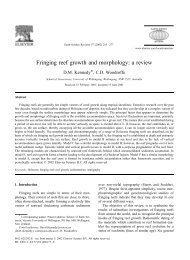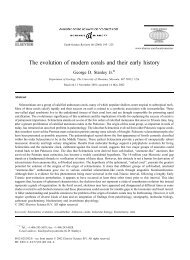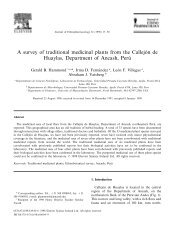Population status of the Orinico crododile in Venezuela
Population status of the Orinico crododile in Venezuela
Population status of the Orinico crododile in Venezuela
Create successful ePaper yourself
Turn your PDF publications into a flip-book with our unique Google optimized e-Paper software.
360 A.E. Seijas, C. ChaÂvez / Biological Conservation 94 (2000) 353±361<br />
The Or<strong>in</strong>oco crocodile population <strong>in</strong> <strong>the</strong> CRS is not<br />
uniformly distributed. Di€erences <strong>in</strong> size and structure<br />
were observed among <strong>the</strong> several river reaches that were<br />
surveyed from 1991 to 1997. The highest densities were<br />
found <strong>in</strong> CAS, a stretch <strong>of</strong> <strong>the</strong> CRS that ma<strong>in</strong>ta<strong>in</strong>s its<br />
meander<strong>in</strong>g condition and is still surrounded by forest.<br />
This result is <strong>in</strong> general agreement with data reported by<br />
AyarzaguÈ ena (1987) for <strong>the</strong> same location. Densities <strong>of</strong><br />
crocodiles decrease upstream <strong>in</strong> CAN and CON, areas<br />
that are a€ected by deforestation, channelization and<br />
contam<strong>in</strong>ation (Seijas, 1998).<br />
Our results for SUC and CUL sections represent <strong>the</strong><br />
®rst data on <strong>the</strong> population <strong>status</strong> <strong>of</strong> crocodile at <strong>the</strong>se<br />
localities. Here, <strong>the</strong> Or<strong>in</strong>oco crocodile population is<br />
extremely low, particularly near Sucre. These river sections<br />
are <strong>the</strong> only ones <strong>of</strong> <strong>the</strong> study area that are navigable<br />
year-round. There is commercial and subsistence<br />
®sh<strong>in</strong>g and, possibly illegal caiman hunt<strong>in</strong>g, around<br />
Sucre and <strong>in</strong> La Culebra. Accidental or <strong>in</strong>tentional kill<strong>in</strong>g<br />
<strong>of</strong> Or<strong>in</strong>oco crocodiles by people may prevent <strong>the</strong><br />
recovery <strong>of</strong> <strong>the</strong> species crocodile <strong>in</strong> <strong>the</strong>se areas, although<br />
we did not obta<strong>in</strong> direct evidence <strong>of</strong> this.<br />
If data from SUC and CUL are removed, densities <strong>of</strong><br />
crocodiles <strong>in</strong> <strong>the</strong> CRS are very high (from 3.08 to 7.43<br />
<strong>in</strong>d./km) compared to <strong>the</strong>se reported by Thorbjarnarson<br />
and Herna ndez (1992) for <strong>the</strong> Tucupido (before it was<br />
dammed) and <strong>the</strong> Capanaparo rivers (1.94 and 1.64 <strong>in</strong>d/<br />
km, respectively). These contrast<strong>in</strong>g ®gures are paradoxical<br />
because, compared to <strong>the</strong> CRS, <strong>the</strong> Capanaparo<br />
river is relatively isolated from important human settlements<br />
and is regarded as good crocodile habitat by<br />
Thorbjarnarson and Herna ndez (1992). However, egg<br />
predation and collection <strong>of</strong> hatchl<strong>in</strong>gs by humans,<br />
management problems known from <strong>the</strong> Capanaparo<br />
river (Thorbjarnarson and Herna ndez, 1992), are factors<br />
<strong>of</strong> marg<strong>in</strong>al importance <strong>in</strong> <strong>the</strong> CRS (Gonza lez-<br />
Ferna ndez, 1995).<br />
<strong>Population</strong> structure di€ered among river sections.<br />
CON and CAN were dom<strong>in</strong>ated by small crocodiles<br />
(less than 1.2 m <strong>in</strong> TL), which accounted for 56.2% <strong>of</strong><br />
<strong>the</strong> crocodiles seen. In contrast, <strong>the</strong> crocodile population<br />
<strong>in</strong> CAS was composed largely <strong>of</strong> sub-adults and<br />
adults (>1.8 m <strong>in</strong> TL). CAM showed an <strong>in</strong>termediate<br />
population structure. These dissimilarities may be partially<br />
expla<strong>in</strong>ed by di€erences <strong>in</strong> habitat quality among<br />
sections. The pr<strong>in</strong>cipal nest<strong>in</strong>g beaches are found <strong>in</strong><br />
CAS (Seijas, 1998). Di€erences <strong>in</strong> mortality may also<br />
play a role <strong>in</strong> structur<strong>in</strong>g <strong>the</strong>se populations. The <strong>in</strong>jury<br />
rate <strong>of</strong> juvenile crocodiles is lower <strong>in</strong> nor<strong>the</strong>rn sections<br />
than <strong>in</strong> <strong>the</strong> sou<strong>the</strong>rn sections <strong>of</strong> <strong>the</strong> CRS, which may<br />
<strong>in</strong>dicate a higher risk <strong>of</strong> predation <strong>in</strong> sou<strong>the</strong>rn localities<br />
(Seijas, 1998).<br />
An alternative explanation for di€erences <strong>in</strong> population<br />
structure among localities is that sites composed<br />
predom<strong>in</strong>antly <strong>of</strong> juveniles (CON and CAN) may be<br />
recover<strong>in</strong>g from overexploitation (Webb and Messel,<br />
1978; Rebelo and Magnusson, 1983). In <strong>the</strong> case <strong>of</strong><br />
CAN it is more plausible to th<strong>in</strong>k that <strong>the</strong> Or<strong>in</strong>oco<br />
crocodile is simply coloniz<strong>in</strong>g that river stretch. Most <strong>of</strong><br />
CAN is an arti®cial channel which has received <strong>the</strong><br />
water <strong>of</strong> <strong>the</strong> Cojedes river only s<strong>in</strong>ce <strong>the</strong> 1960s (PedranÄ<br />
ez 1980; Campo and RodrõÂ guez, 1995).<br />
F<strong>in</strong>ally, population structures may be shaped by<br />
human activities. Large crocodiles are more conspicuous<br />
and probably more frequently killed by people.<br />
Areas surround<strong>in</strong>g CON and CAN are more developed<br />
and encounters betwee human and crocodiles may occur<br />
with <strong>in</strong>creased frequency. Fewer adults could rema<strong>in</strong> <strong>in</strong><br />
<strong>the</strong> river under <strong>the</strong>se circumstances, and <strong>the</strong> less conspicuous<br />
juveniles may escape detection, although at<br />
lower densities than juveniles at CAS. In river sections less<br />
accessible to humans, such as CAS, large crocodiles may<br />
have greater chances to survive and became established as<br />
a reproductive population.<br />
The procedures reported here and <strong>the</strong> population<br />
<strong>in</strong>dices derived from <strong>the</strong>m, represent <strong>the</strong> ®rst attempt to<br />
standardize methodology for <strong>the</strong> study <strong>of</strong> <strong>the</strong> Or<strong>in</strong>oco<br />
crocodile population <strong>in</strong> <strong>the</strong> CRS, <strong>the</strong> most important<br />
population <strong>of</strong> this endangered species. These results<br />
serve as a basel<strong>in</strong>e for future <strong>in</strong>vestigation <strong>of</strong> <strong>the</strong> species<br />
<strong>in</strong> <strong>the</strong> area.<br />
Acknowledgements<br />
This study was made possible by a grant from <strong>the</strong><br />
Wildlife Conservation Society (WCS). Satellite images<br />
were generously donated by U. S. Geological Survey<br />
(EROS Data Center). Coromoto RamõÂ rez, Jevert GonzaÂ<br />
lez and Eddy Escalona served as our guides on many<br />
occasions. We appreciate also <strong>the</strong> hospitality o€ered by<br />
Pedro Rojas, Jose Rodrõ guez, and Jose Caicedo at <strong>the</strong><br />
MARNR station <strong>in</strong> Toma Cojedes, San Rafael de Onoto.<br />
Early versions <strong>of</strong> <strong>the</strong> manuscript were reviewed by F. W.<br />
K<strong>in</strong>g, John Thorbjarnarson, Richard Bodmer, Melv<strong>in</strong><br />
Sunquist, and George Tanner. Robert Godshalk, Craig<br />
Guyer and two anonymous reviewers made important<br />
contributions to <strong>the</strong> improvement <strong>of</strong> <strong>the</strong> paper.<br />
References<br />
Arteaga, A., CanÄ izales, I., Herna ndez, G., Lamas, M. C., De Luca, A.,<br />
MunÄ oz, M. et al., 1997. Taller de ana lisis de la viabilidad poblacional<br />
y del ha bitat del Caima n del Or<strong>in</strong>oco (Crocodylus <strong>in</strong>termedius).<br />
IUCN/SSC Conservation Breed<strong>in</strong>g Specialist Group: Apple Valley,<br />
MN.<br />
AyarzaguÈ ena, J., 1987. Conservacio n del caima n del Or<strong>in</strong>oco (Crocodylus<br />
<strong>in</strong>termedius) en <strong>Venezuela</strong>. Parte I. RõÂ o Cojedes. FUDENA,<br />
WWF-US, Proyecto 6078.<br />
AyarzaguÈ ena, J., 1990. An update on <strong>the</strong> recovery program for <strong>the</strong><br />
Or<strong>in</strong>oco crocodile. Crocodile Specialist Group Newsletter 9, 16±18.<br />
Brazaitis, P., 1973. The identi®cation <strong>of</strong> liv<strong>in</strong>g crocodilians. Zoologica<br />
58, 59±101.






